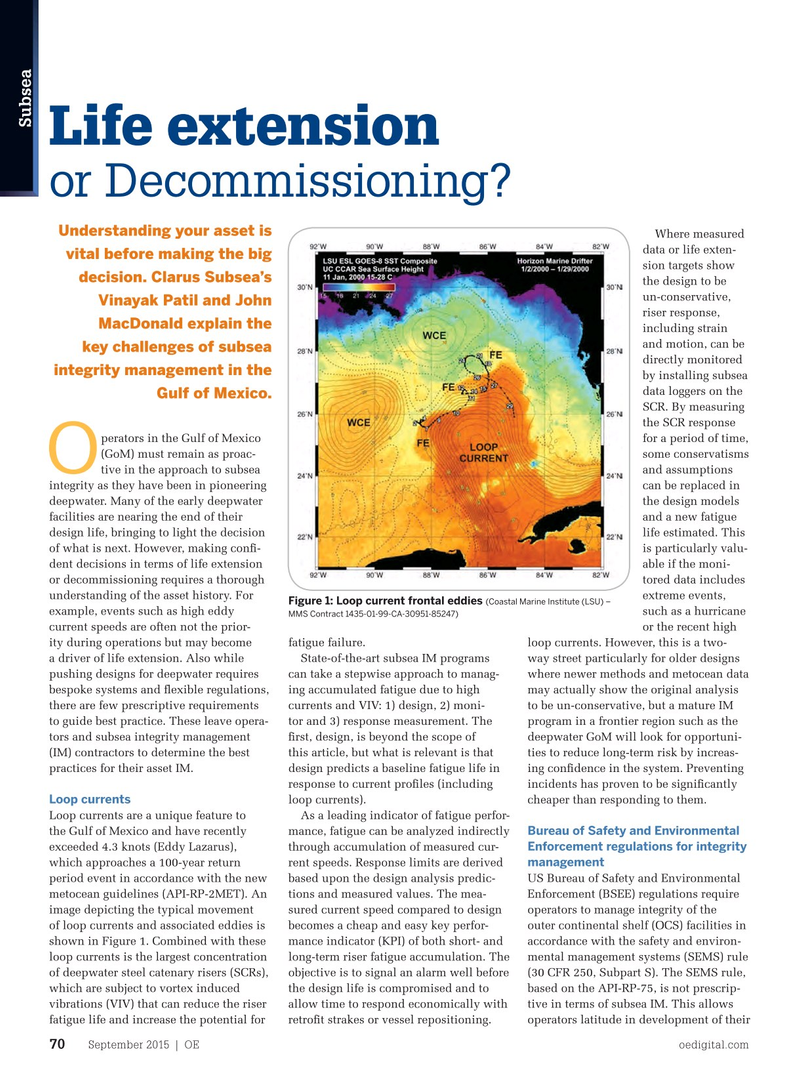
Page 68: of Offshore Engineer Magazine (Sep/Oct 2015)
Read this page in Pdf, Flash or Html5 edition of Sep/Oct 2015 Offshore Engineer Magazine
Subsea
Life extension or Decommissioning?
Understanding your asset is
Where measured data or life exten- vital before making the big sion targets show decision. Clarus Subsea’s the design to be un-conservative,
Vinayak Patil and John riser response,
MacDonald explain the including strain and motion, can be key challenges of subsea directly monitored integrity management in the by installing subsea data loggers on the
Gulf of Mexico.
SCR. By measuring the SCR response perators in the Gulf of Mexico for a period of time, (GoM) must remain as proac- some conservatisms
O tive in the approach to subsea and assumptions integrity as they have been in pioneering can be replaced in deepwater. Many of the early deepwater the design models facilities are nearing the end of their and a new fatigue design life, bringing to light the decision life estimated. This of what is next. However, making conf- is particularly valu- dent decisions in terms of life extension able if the moni- or decommissioning requires a thorough tored data includes understanding of the asset history. For extreme events,
Figure 1: Loop current frontal eddies (Coastal Marine Institute (LSU) – example, events such as high eddy such as a hurricane
MMS Contract 1435-01-99-CA-30951-85247) current speeds are often not the prior- or the recent high ity during operations but may become fatigue failure. loop currents. However, this is a two- a driver of life extension. Also while State-of-the-art subsea IM programs way street particularly for older designs pushing designs for deepwater requires can take a stepwise approach to manag- where newer methods and metocean data bespoke systems and fexible regulations, ing accumulated fatigue due to high may actually show the original analysis there are few prescriptive requirements currents and VIV: 1) design, 2) moni- to be un-conservative, but a mature IM to guide best practice. These leave opera- tor and 3) response measurement. The program in a frontier region such as the tors and subsea integrity management frst, design, is beyond the scope of deepwater GoM will look for opportuni- (IM) contractors to determine the best this article, but what is relevant is that ties to reduce long-term risk by increas- practices for their asset IM. design predicts a baseline fatigue life in ing confdence in the system. Preventing response to current profles (including incidents has proven to be signifcantly
Loop currents loop currents). cheaper than responding to them.
Loop currents are a unique feature to As a leading indicator of fatigue perfor-
Bureau of Safety and Environmental the Gulf of Mexico and have recently mance, fatigue can be analyzed indirectly
Enforcement regulations for integrity exceeded 4.3 knots (Eddy Lazarus), through accumulation of measured cur- management which approaches a 100-year return rent speeds. Response limits are derived period event in accordance with the new based upon the design analysis predic- US Bureau of Safety and Environmental metocean guidelines (API-RP-2MET). An tions and measured values. The mea- Enforcement (BSEE) regulations require image depicting the typical movement sured current speed compared to design operators to manage integrity of the of loop currents and associated eddies is becomes a cheap and easy key perfor- outer continental shelf (OCS) facilities in shown in Figure 1. Combined with these mance indicator (KPI) of both short- and accordance with the safety and environ- loop currents is the largest concentration long-term riser fatigue accumulation. The mental management systems (SEMS) rule of deepwater steel catenary risers (SCRs), objective is to signal an alarm well before (30 CFR 250, Subpart S). The SEMS rule, which are subject to vortex induced the design life is compromised and to based on the API-RP-75, is not prescrip- vibrations (VIV) that can reduce the riser allow time to respond economically with tive in terms of subsea IM. This allows fatigue life and increase the potential for retroft strakes or vessel repositioning. operators latitude in development of their
September 2015 | OE oedigital.com 70 070_OE0915_Subsea2_Clarus.indd 70 8/19/15 6:31 PM

 67
67

 69
69